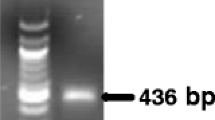Abstract
We developed a real-time PCR assay using a TaqMan probe (TM-qPCR) for specific detection and quantification of Phomopsis sclerotioides, causal agent of black root rot of cucurbit crops. The design of the primer sets and hybridization probe was based on the internal transcribed spacer region of the ribosomal DNA. The TM-qPCR assay was compared with a conventional, standard PCR (sPCR) assay and on a quantitative real-time PCR (SG-qPCR) assay based on SYBR Green I. The TM-qPCR assay had a detection limit of ca. 0.4 fg of P. sclerotioides DNA, which was approximately 100 times more sensitive than the sPCR assay and almost equivalent to the SG-qPCR assay. The TM-qPCR and SG-qPCR assays both were able to detect various quantities of P. sclerotioides DNA from diseased plants and infested soils, including DNA levels that were not detectable by the sPCR assay. However, the TM-qPCR was advantageous for samples containing PCR-inhibiting substances because its multiplex real-time PCR function allows the adjustment of cycle threshold values with an internal control. Based on the high specificity and sensitivity required for analyzing DNA in natural samples, the newly developed TM-qPCR assay was the most reliable tool for rapidly detecting and quantifying P. sclerotioides in plant and soil samples.




Similar content being viewed by others
References
Bridge P, Spooner B (2001) Soil fungi: diversity and detection. Plant Soil 232:147–154
Cappelli C, Stravato VM, Carannante G, Parisella R (2004) First report of cucumber black root rot caused by Phomopsis sclerotioides in Italy (Abstract). Plant Dis 88:425
Cullen DW, Hirsch PR (1998) Simple and rapid method for direct extraction of microbial DNA from soil for PCR. Soil Biol Biochem 30:983–993
Farr DF, Castlebury LA, Rossman AY, Putnam ML (2002) A new species of Phomopsis causing twig dieback of Vaccinium vitis-idaea (lingonberry). Mycol Res 106:745–752
Kim TG, Knudsen GR (2008) Quantitative real-time PCR effectively detects and quantifies colonization of sclerotia of Sclerotinia sclerotiorum by Trichoderma spp. Appl Soil Ecol 40:100–108
Klerks MM, Zijlstra C, van Bruggen AHC (2004) Comparison of real-time PCR methods for detection of Salmonella enterica and Escherichia coli O157:H7, and introduction of a general internal amplification control. J Microbiol Methods 59:337–349
Larsen RC, Vandemark GJ, Hughes TJ, Grau CR (2007) Development of a real-time polymerase chain reaction assay for quantifying Verticillium albo-atrum DNA in resistant and susceptible alfalfa. Phytopathology 97:1519–1525
Momma N, Yamamoto K, Simandi P, Shishido M (2006) Role of organic acids in the mechanisms of biological soil disinfestation (BSD). J Gen Plant Pathol 72:247–252
Schena L, Nigro F, Ippolito A, Gallitelli D (2004) Real-time quantitative PCR: a new technology to detect and study phytopathogenic and antagonistic fungi. Eur J Plant Pathol 110:893–908
Shishido M, Yoshida N, Usami T, Shinozaki T, Kobayashi M, Takeuchi T (2006) Black root rot of cucurbits caused by Phomopsis sclerotioides in Japan and phylogenetic grouping of the pathogen. J Gen Plant Pathol 72:220–227
Shishido M, Sato K, Yoshida N, Tsukui R, Usami T (2010) PCR-based assays to detect and quantify Phomopsis sclerotioides in plants and soil. J Gen Plant Pathol 76:21–30
van Gent-Pelzer MPE, Krijger M, Bonants PJM (2010) Improved real-time PCR assay for detection of the quarantine potato pathogen, Synchytrium endobioticum, in zonal centrifuge extracts from soil and in plants. Eur J Plant Pathol 126:129–133
van Kesteren HA (1966) “Black root rot” in cucurbitaceae caused by Phomopsis sclerotioides nov. spec. Neth J Plant Pathol 73:112–116
Wittwer CT, Herrmann MG, Moss AA, Rasmussen RP (1997) Continuous fluorescence monitoring of rapid cycle DNA amplification. Biotechniques 22:130–138
Acknowledgments
This study was supported in part by Grant-in-Aid for Scientific Research (21580052) from the Japan Society for the Promotion of Science. We thank Dr. A. Rossman of USDA-ARS for supplying P. columnaris. We are also grateful to N. Yoshida of Chiba Prefecture Government for supplying soil samples naturally infested with black root rot of watermelon.
Author information
Authors and Affiliations
Corresponding author
Rights and permissions
About this article
Cite this article
Shishido, M., Kubota, I., Ohashi, T. et al. Comparison of PCR assays for detection and quantification of Phomopsis sclerotioides in plant and soil. J Gen Plant Pathol 79, 18–27 (2013). https://doi.org/10.1007/s10327-012-0415-5
Received:
Accepted:
Published:
Issue Date:
DOI: https://doi.org/10.1007/s10327-012-0415-5




